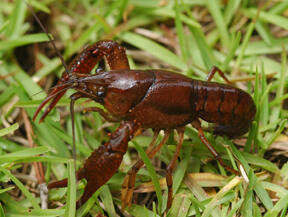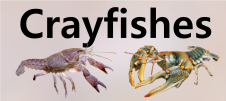







Loading profile. Please wait . . .
Procambarus howellae Hobbs, 1952
Ornate Crayfish




Federal Protection: No US federal protection
State Protection: No Georgia state protection
Global Rank: G5
State Rank: S5
Element Locations Tracked in Biotics: No
SWAP 2015 Species of Greatest Conservation Need (SGCN): No
SWAP 2025 Species of Greatest Conservation Need (SGCN): No
2025 SGCN Priority Tier: None
Element Occurrences (EOs) in Georgia: 0
Habitat Summary for element in Georgia: Associated with vegetation or woody debris in streams or ditches; simple burrows where waters have receded
The overall color of the Ornate Crayfish includes reds, reddish-browns, and pinkish hues. The back is dark reddish brown and the upper sides have a dark longitudinal stripe. Below the stripe the body is pinkish-cream with white speckles and whitish splotching. There are numerous small, dark tubercles on the carapace. The abdomen has dark transverse bars on each segment which create the appearance of a broad, dark longitudinal stripe. The claws are dark red to blackish with bright orangish-reddish tubercles. The areola is narrow and may be obliterated. The rostrum is long and pointed and often has marginal spines or tubercles, especially on juveniles. A single cervical tubercle is usually present and may be a sharp spine on juveniles. This species reaches a maximum total body length of about 90 mm (3.5 in).
Across most of its range, there are no other crayfish species with orangish-reddish tubercles on the claws. At the eastern and western portions of its range, the Ornate Crayfish abuts the ranges of its close relatives, Eastern Red Swamp Crawfish (Procambarus troglodytes) and Peninsula Crayfish (P. paeninsulanus). Details of the male reproductive structure are required to separate these species from one another. Another species that must be considered is the Red Swamp Crawfish (P. clarkii), a non-native species widely introduced around the world as a food source for people. There are currently no known populations within the range of Ornate Crayfish, but it is possible they could turn up. Again, details of the male reproductive structure are required to separate this species from Ornate Crayfish.
The Ornate Crayfish occurs in permanent streams as well as temporary habitats such as ditches and ponds. In streams it is usually associated with vegetation or woody debris or undercut banks. In areas where open water recedes, it can be found in simple burrows (Hobbs 1981).
No studies of the Ornate Crayfish are known. Crayfishes are considered opportunistic omnivores and likely feed on live and decaying vegetation, aquatic insect larvae, small fishes, and dead animal matter.
Stream dwelling crayfishes typically hide during the day and come out at night to feed. Reproduction usually occurs during the spring and fall, but males in reproductive condition may be found at any time during the year. When female crayfish are ready to lay eggs, they usually find a secure hiding place and hence are rarely encountered. When the eggs are released, the female attaches them to her swimmerets and is said to be “in berry.” Upon hatching, the juvenile crayfish are attached to the mother by a thread. After the juveniles molt for the second time, they are free of the mother, but stay close and will hold on to her for some time. Eventually they move off on their own. Crayfishes molt 6 or 7 times during their first year of life and most are probably able to reproduce by the end of that year. Male Ornate Crayfish in reproductive condition have been collected in February, March, April, May, June, and November. A single female with eggs was found in a burrow in June (Hobbs 1981). The lack of female specimens carrying eggs suggests that they retreat to burrows to lay eggs and rear young. The smallest breeding male known is about 56 mm (2.2 in) and the female with eggs is about 58 mm (2.3 in) in length (Hobbs 1981).
Since this species is usually found in flowing water, it is most easily collected by holding a net perpendicular to the current downstream of vegetation or woody debris and kicking to dislodge and scare crayfish into the net. If there are rocks or logs in the creek, they may be carefully lifted and crayfish may be pinned by hand or coaxed into a dipnet. The use of a backpack electroshocker or baited minnow traps set overnight may be effective as well. Excavation of burrows adjacent to drying ponds or ditches may also yield specimens.
The Ornate Crayfish is found only in Georgia and is widespread across the south-central portion of the state. Based on Hobbs (1981), it is most common in the lower Ocmulgee River system, but there are also records from the Altamaha, Flint, Oconee, Ohoopee, and Savannah river systems.
This species is threatened in Georgia by land uses within its range that could alter hydrology and water quality. Introduction of non-native species is a threat to all native crayfishes.
This species is common and widespread in Georgia and is thus considered secure.
Conserving populations of the Ornate Crayfish will require general watershed level protection measures, including the protection of riparian zones, control of sediment and nutrient runoff from farms and construction sites, and limiting the amount of impervious cover (e.g., pavement) within occupied watersheds. Non-native crayfishes should never be used for bait; instead, anglers should use crayfishes collected from the river system where they will be fishing. Unused bait of any kind should not be released back into Georgia waters.
Hobbs, H.H., Jr. 1981. The crayfishes of Georgia. Smithsonian Contributions to Zoology 318:1–549.
Taylor, C.A., G.A. Schuster, J.E. Cooper, R.J. DiStefano, A.G. Eversole, P. Hamr, H.H. Hobbs III, H.W. Robison, C.E. Skelton, and R.F. Thoma. 2007. A reassessment of the conservation status of crayfishes of the United States and Canada after 10+ years of increased awareness. Fisheries 32:372–389.
Christopher E. Skelton
C. Skelton, August 2012: original account
C. Skelton, March 2019: general update of account.
D.Weiler, October 2019: photo added